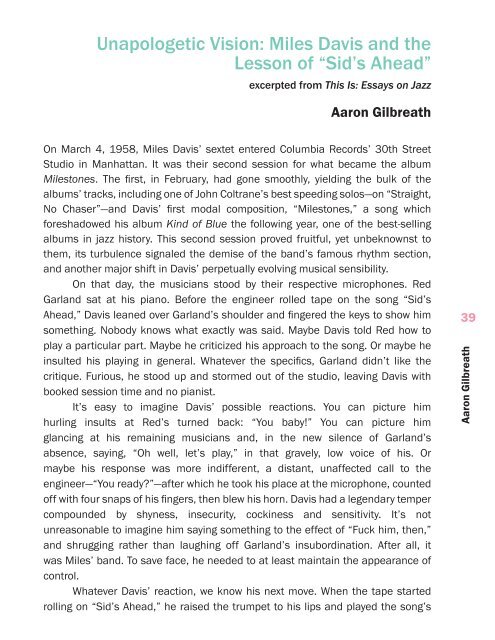Hair Trigger 2.0 Issue Two
The second annual issue of Columbia College Chicago's student-run online literary magazine, Hair Trigger 2.0.
The second annual issue of Columbia College Chicago's student-run online literary magazine, Hair Trigger 2.0.
Create successful ePaper yourself
Turn your PDF publications into a flip-book with our unique Google optimized e-Paper software.
Unapologetic Vision: Miles Davis and the<br />
Lesson of “Sid’s Ahead”<br />
excerpted from This Is: Essays on Jazz<br />
Aaron Gilbreath<br />
On March 4, 1958, Miles Davis’ sextet entered Columbia Records’ 30th Street<br />
Studio in Manhattan. It was their second session for what became the album<br />
Milestones. The first, in February, had gone smoothly, yielding the bulk of the<br />
albums’ tracks, including one of John Coltrane’s best speeding solos—on “Straight,<br />
No Chaser”—and Davis’ first modal composition, “Milestones,” a song which<br />
foreshadowed his album Kind of Blue the following year, one of the best-selling<br />
albums in jazz history. This second session proved fruitful, yet unbeknownst to<br />
them, its turbulence signaled the demise of the band’s famous rhythm section,<br />
and another major shift in Davis’ perpetually evolving musical sensibility.<br />
On that day, the musicians stood by their respective microphones. Red<br />
Garland sat at his piano. Before the engineer rolled tape on the song “Sid’s<br />
Ahead,” Davis leaned over Garland’s shoulder and fingered the keys to show him<br />
something. Nobody knows what exactly was said. Maybe Davis told Red how to<br />
play a particular part. Maybe he criticized his approach to the song. Or maybe he<br />
insulted his playing in general. Whatever the specifics, Garland didn’t like the<br />
critique. Furious, he stood up and stormed out of the studio, leaving Davis with<br />
booked session time and no pianist.<br />
It’s easy to imagine Davis’ possible reactions. You can picture him<br />
hurling insults at Red’s turned back: “You baby!” You can picture him<br />
glancing at his remaining musicians and, in the new silence of Garland’s<br />
absence, saying, “Oh well, let’s play,” in that gravely, low voice of his. Or<br />
maybe his response was more indifferent, a distant, unaffected call to the<br />
engineer—“You ready?”—after which he took his place at the microphone, counted<br />
off with four snaps of his fingers, then blew his horn. Davis had a legendary temper<br />
compounded by shyness, insecurity, cockiness and sensitivity. It’s not<br />
unreasonable to imagine him saying something to the effect of “Fuck him, then,”<br />
and shrugging rather than laughing off Garland’s insubordination. After all, it<br />
was Miles’ band. To save face, he needed to at least maintain the appearance of<br />
control.<br />
Whatever Davis’ reaction, we know his next move. When the tape started<br />
rolling on “Sid’s Ahead,” he raised the trumpet to his lips and played the song’s<br />
39<br />
Aaron Gilbreath




